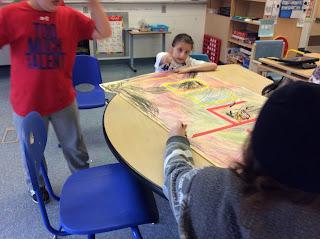
This afternoon in our classroom, during inquiry/student directed learning, I looked around and noticed something..... among our group of 11 students, I could easily observe at least 6 intelligences occurring through various activities. I was impressed with how naturally our students seemed to gravitate towards activities that suit their abilities and interests as well as how students often seemed very attuned to activities and opportunities that are beneficial to them at any given moment. For example, Khayden had been having a bit of a tough day and opted to spend some time on his own, rather than joining his peers. He naturally knew what would help him to feel better and gravitated to that activity.
Please check out our pictures representing some of the multiple intelligences we observed :)
 |
| Owen loves making and listening to music (musical) |
 |
| Lucas, Tommy and Nathan at the science inquiry station (naturalist and mathematical/logical) |
 |
| Khayden spending some down time (Intrapersonal) |
 |
| Dorian, Bhagya, Madison and Lucas creating our school banner for Special Olympics (visual spatial, interpersonal) |











